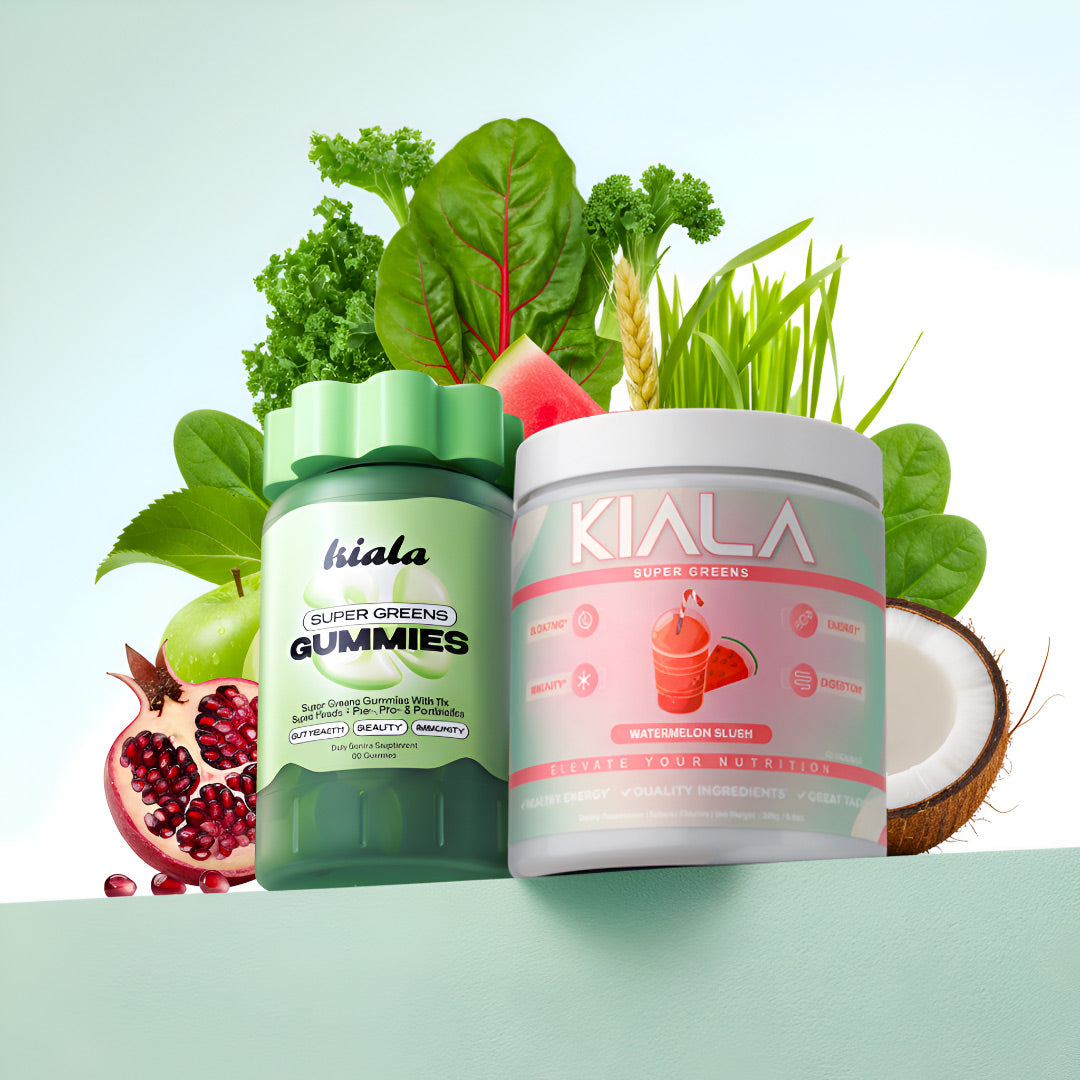Nutrient Timing: Does When You Take Your Greens Actually Matter?
You've mastered what to eat, but now you're spiraling down the rabbit hole of when to eat it. Should you take your supergreens on an empty stomach? With food? Before or after your workout? At exactly 7:23 AM when your cortisol peaks? The internet has opinions about everything, but what does science actually say about nutrient timing?
Let's separate the evidence from the overthinking and figure out if timing your greens intake actually moves the needle on your health.
The Timing Obsession
Nutrient timing has become the latest frontier in optimization culture. We've gone from simply trying to eat well to micromanaging every aspect of when we consume specific nutrients, often creating more stress than benefit.
Dr. Alan Aragon, nutrition researcher and author, explains: "While nutrient timing can have some effects, the magnitude is often overstated. For most people, consistency in overall nutrition patterns matters far more than precise timing."
The Circadian Rhythm Reality
Your Body's Natural Clock: Your digestive system does follow circadian rhythms. Digestive enzyme production, stomach acid secretion, and nutrient absorption all vary throughout the day based on your internal clock.
Morning Optimization: Research shows that insulin sensitivity is typically highest in the morning, making it an optimal time for nutrient intake. Your body is primed to process and utilize nutrients efficiently after the overnight fasting period.
The Cortisol Connection: Cortisol naturally peaks in the morning, which can enhance nutrient uptake and utilization. This natural rhythm suggests that morning nutrient intake aligns with your body's preparation for the day ahead.
The Morning Advantage
Enhanced Absorption: Studies published in Chronobiology International show that many nutrients are better absorbed in the morning when digestive function is optimized and the body is prepared for the day's energy needs.
Sustained Energy Benefits: Taking nutrient-dense supergreens in the morning provides sustained energy throughout the day. B-vitamins from spirulina and wheatgrass support energy metabolism when your body needs it most.
Dr. Satchin Panda, circadian rhythm researcher at the Salk Institute, notes: "Aligning nutrient intake with circadian rhythms can enhance metabolic efficiency and improve how the body utilizes nutrients throughout the day."
The Hydration Factor: Starting your day with supergreens mixed in water addresses overnight dehydration while providing nutrients. The combination of natural electrolytes from coconut water powder with comprehensive nutrition supports optimal hydration status.
The Empty Stomach Debate
Enhanced Bioavailability: Some nutrients are better absorbed on an empty stomach when they don't have to compete with other foods for absorption pathways. This is particularly true for certain vitamins and minerals.
The Gentle Advantage: Unlike harsh supplements that can cause stomach irritation when taken alone, quality supergreens are generally well-tolerated on an empty stomach due to their whole-food nature and digestive-supporting ingredients.
Individual Tolerance: While many people thrive taking supergreens on an empty stomach, others prefer them with food. Pay attention to your body's response rather than following rigid rules.
The Pre-Workout Consideration
Energy Support: B-vitamins and natural compounds in supergreens can provide gentle energy support for morning workouts without the jitters associated with high-caffeine pre-workout supplements.
Antioxidant Protection: Taking antioxidant-rich supergreens before exercise provides cellular protection against the oxidative stress generated during intense physical activity.
The Timing Window: Research suggests consuming antioxidants 30-60 minutes before exercise optimizes their protective effects. The compounds in green tea extract, berries, and other supergreens ingredients fit this timeline well.
The Post-Workout Recovery
Anti-Inflammatory Support: Compounds like turmeric and green tea extract in supergreens provide anti-inflammatory support that can aid post-workout recovery when consumed after exercise.
Nutrient Replenishment: Exercise depletes various nutrients, particularly antioxidants and B-vitamins. Supergreens can help replenish these nutrients during the post-workout recovery window.
Hydration and Electrolytes: The natural electrolytes in quality supergreens support post-workout hydration needs without artificial additives found in many sports drinks.
The Meal Timing Factor
With Food Benefits: Some nutrients are better absorbed when consumed with other foods. Fat-soluble vitamins benefit from being consumed with dietary fats, while certain minerals are enhanced by food matrices.
Digestive Comfort: People with sensitive stomachs often find that taking supergreens with a small amount of food reduces any potential digestive sensitivity.
The Synergy Effect: Consuming supergreens as part of a balanced meal creates nutrient synergies that can enhance overall absorption and utilization.
The Consistency Principle
Habit Formation: The most important timing factor might be consistency. Taking your supergreens at the same time each day creates a sustainable habit that's easier to maintain long-term.
Circadian Entrainment: Regular timing helps entrain your body's circadian rhythms, potentially enhancing the beneficial effects of the nutrients over time.
Dr. Michael Roizen, preventive medicine specialist, emphasizes: "Consistency in timing often matters more than perfect timing. A good habit maintained daily outperforms perfect timing followed sporadically."
The Individual Response
Bio-Individuality: Everyone's digestive system, circadian rhythms, and lifestyle factors are different. What works optimally for one person might not be ideal for another.
Lifestyle Integration: The best timing is the one that fits seamlessly into your existing routine. If morning doesn't work for your schedule, consistent afternoon or evening consumption is better than sporadic morning intake.
The Tolerance Factor: Some people digest nutrients better at certain times of day. Pay attention to how your body responds and adjust accordingly.
The Practical Approach
Morning Foundation: For most people, morning consumption provides the best combination of absorption, energy support, and habit formation. With over 1 million women incorporating supergreens into their morning routines, there's clear evidence that this timing works well for sustainable health practices.
Convenience Matters: The timing that allows for consistency is more important than theoretical optimization. Choose a time you can maintain regardless of your schedule changes.
Quality Over Timing: A high-quality supergreens formulation with organic ingredients and natural flavors like Mixed Berry or Tropical Splash will provide benefits regardless of exact timing.
The Travel and Schedule Factor
Flexibility Benefits: Unlike rigid supplement protocols that require precise timing, supergreens can adapt to changing schedules while maintaining their benefits.
Time Zone Adaptation: When traveling across time zones, maintaining your supergreens routine can help support circadian rhythm adjustment and provide consistent nutrition despite schedule disruptions.
The Stress Factor: Worrying about perfect timing can create stress that negates any potential benefits. Flexibility and consistency matter more than perfection.
The Research Reality
Limited Evidence: While circadian nutrition research is fascinating, most studies on specific timing protocols are conducted in controlled laboratory settings that don't reflect real-world conditions.
Magnitude of Effect: The benefits of optimal timing, while real, are typically small compared to the benefits of consistent, quality nutrition regardless of timing.
Individual Variation: Research shows significant individual variation in optimal timing, making general recommendations less applicable to specific individuals.
The Bottom Line
While nutrient timing can provide small benefits, consistency and quality matter far more than perfect timing. The best time to take your supergreens is the time you can maintain consistently as part of a sustainable routine.
Morning consumption offers several advantages—enhanced absorption, energy support, and easier habit formation—making it the optimal choice for most people. However, any consistent timing that fits your lifestyle will provide substantial benefits.
Don't let timing perfectionism prevent you from establishing a consistent nutrition routine. The most important factor is showing up for your health daily, regardless of whether it's at the "perfect" time.
Your body is remarkably adaptable and will make excellent use of quality nutrition whenever you provide it. Focus on consistency over optimization, and let timing be one less thing to stress about in your wellness routine.
Sources:
-
Aragon, A., & Schoenfeld, B. (2013). Nutrient timing revisited: is there a post-exercise anabolic window? Journal of the International Society of Sports Nutrition, 10(1), 5.
-
Panda, S. (2018). The Circadian Code. Rodale Books.
-
Scheer, F. A., et al. (2013). Adverse metabolic and cardiovascular consequences of circadian misalignment. Proceedings of the National Academy of Sciences, 110(4), 1519-1524.
-
Roizen, M., & Oz, M. (2012). You: On a Diet. Free Press.
-
Johnston, J. D. (2014). Physiological responses to food intake throughout the day. Nutrition Research Reviews, 27(1), 107-118.
Ready to establish a consistent, beneficial nutrition routine? Discover supergreens that work with your schedule, not against it. Sometimes the best timing is simply the timing you'll actually stick with.
Read more

I Stopped Eating Salads for 30 Days and My Bloating Disappeared This is going to be controversial, but hear me out: salads might not be the health heroes we've been told they are. For years, I duti...

Supplement Shaming is So 2023: Why Smart Women Don't Apologize for Optimization Picture this: You're at brunch, casually mentioning your morning routine includes a greens powder, and suddenly Karen...















